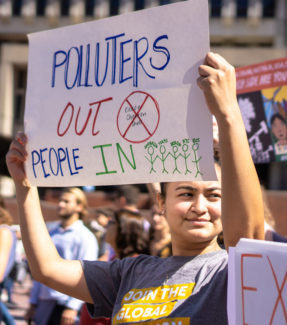Originally published for Gizmodo by Brian Kahn.
The NFT space has a ballooning carbon problem. But rather than address emissions head-on, platforms may be turning to at best, self-deception and at worst, greenwashing by relying on carbon offsets.
Over the weekend, the platform Nifty Gateway ran an auction dubbed the #CarbonDrop that was, it said, “inspired around climate change.” The auction included a Beeple piece that went for $6 million along with a host of other artists whose work sold for an additional $600,000. The proceeds benefited the Open Earth Foundation, a nonprofit focused on using the blockchain for climate accountability and tracking emissions. To deal with the estimated 500 tons of emissions associated with the auction, the artists were all given carbon offsets. The problem with these offsets is that they don’t actually reduce emissions, they just—as the name says—offset them through activities like planting trees.
Some research and reporting also indicate that offsets may even fail in that regard. A ProPublica investigation found that a number of forestry projects in Brazil actually led to a decrease in forest cover. Climate change itself can upend even the best-intentioned and designed forest offsets; in Oregon this summer, forests set aside for offsets caught on fire, sending carbon into the atmosphere instead of sequestering it.
Yet, in tweets about the auction, Tyler Winklevoss—one of the Winklevoss twins, owners of Nifty Gateway—declared victory, saying that the “entire NFT industry is now carbon negative thanks to The Carbon Drop,” which is a lie. He also noted that Nifty Gateway is “carbon negative by 42x,” which means absolutely nothing but sure sounds nice. What this framing does do, though, is give the platform an excuse to delay taking part in actions that could meaningfully reduce emissions.
While some lucky (and rich) buyers now own some art and a nonprofit has some serious coin to help their mission, there’s a real risk that how the auction was conducted obscures the bigger problems with the platforms undergirding the crypto art and the technology in general.
Nifty Gateway is the second-most polluting NFT platform out there, according to multiple lines of research. An analysis by artist Kyle McDonald put Nifty Gateway’s carbon emissions through March 22 at 13,170 tons, second only to Open Sea. Nifty Gateway sits atop the Ethereum blockchain, a platform that allows artists (or others) to mint tokens that can be tied as a sort of certificate of authenticity to nearly anything, including digital art. Ethereum relies on proof of work, a process that ends up wasting loads of energy as a bunch of computers around the world work to mine the next block by solving a problem. Ethereum’s developers have claimed to have a fix in the works for years to reduce its impact by switching to a different method called proof of stake, yet the shift continues to be delayed.
Carbon pollution is a zero-sum problem we can’t offset our way out of. Yes, some offsets may be necessary for hard-to-decarbonize sectors like cement production or aviation. But to stave off the worst impacts of climate change, the real work of decarbonization needs to start now, including around NFTs. And while individual artists can do their best to counterbalance their impact, the reality is that a systemic shift needs to happen, and it’s unclear how this weekend’s auction addresses that.
“They’re falling right into the trap the fossil fuel industry has laid, relying on an old way of producing energy and a fantastical approach to mitigating emissions instead of, as a fairly nascent technology and industry, finding a new way,” Jesse Bragg, the media director of the nonprofit Corporate Accountability, said of Nifty Gateway. “There are plenty of options to do what they’re doing in a much less harmful way. Instead, they’re doing what a lot of corporations are doing: Rely fossil fuel infrastructure and then rely on offsets to greenwash their image.”
None of this is a knock on the artists who participated, nor the buyers, nor those offering the offsets and clearly believe in them.
“Carbon offsets get a lot of scrutiny, and rightfully so, on their transparency and end-to-end verification,” said Josh Bijak, the CTO of Creol, and in a very Silicon Valley twist, also a project lead at distributed graphics firm Render Token, which sponsored the auction. “So we just basically said, OK, let’s add one more on layer to it,” by making NFTs for them so they could be verifiable with a unique token.
But offsets do not do the work needed for the scale of the problem. And the problem transcends individuals or even NFTs alone. NFTs are only a small sum of Ethereum’s estimated 13.89 megatons of annual carbon pollution, a total that slots the network just ahead of oil-rich Bahrain, according to Digiconomist.
There’s certainly an argument to be made that artists should withhold their labor until these problems are addressed. Artist Joanie Lemercier was slated to have work in the auction, but backed out citing Nifty Gateway’s reversal on implementing a change in how transactions occur that would’ve reduced the climate impact. Yet the auction went on, and more high-profile drops continue by the day, with promises of offsets becoming more common.
Public pressure could turn the heat on platforms that use Ethereum to advocate for change or switch to less damaging crypto networks. Cryptocurrency traders could threaten to divest from carbon-intensive currencies unless conditions for less ecological damage they want to see are met. But ultimately, as with anything climate-related, it requires collective action. That may seem anathema to the notoriously libertarian-leaning cryptocurrency space, but failing to fight together for solutions could mean the destruction of the one thing we all have in common.



